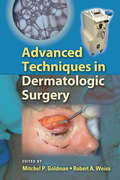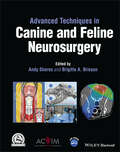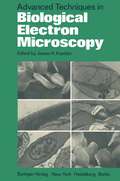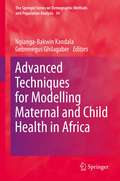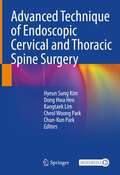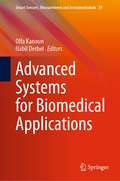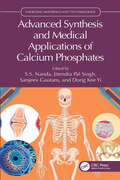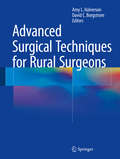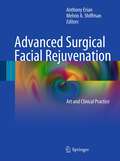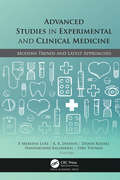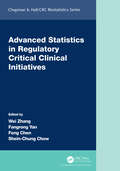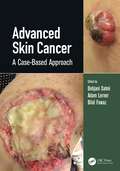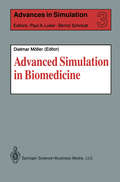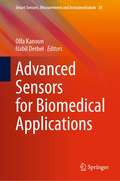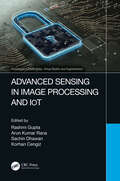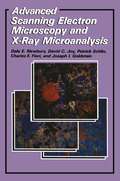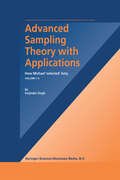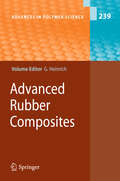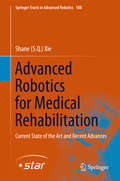- Table View
- List View
Advanced Techniques in Dermatologic Surgery
by Mitchel P. Goldman Robert A. WeissCompiled by seasoned experts in the field, this reference provides clear guidance on the basic principles, procedures, and complications involved in advanced dermatologic surgery-offering detailed coverage of filling substances, fat transfer techniques, and the latest laser technologies.
Advanced Techniques in Canine and Feline Neurosurgery
by Andy ShoresAdvanced Techniques in Canine and Feline Neurosurgery An up-to-date discussion of the latest advanced neurosurgical techniques for dogs and cats In Advanced Techniques in Canine and Feline Neurosurgery, a team of distinguished veterinary practitioners delivers an authoritative and accessible compilation of current best practices for surgery of the spine, neck, and head in dogs and cats. The book focuses on advanced and cutting-edge techniques in the field, offering detailed and step-by-step descriptions of state-of-the-art procedures accompanied by video clips of most. The authors have developed a companion website that includes additional resources for the techniques described in the book, which provides coverage of percutaneous laser disk fenestration, spinal stabilization, and pituitary surgery. Each chapter presents a detailed description of an operative technique, indications, surgical anatomy, and related and detailed illustrations. Readers will also find: A thorough introduction to the history of veterinary neurosurgery and applications of 3D printing in veterinary neurosurgery In-depth treatments of post-operative radiation therapy of intracranial tumors Comprehensive discussions of the more routine spinal procedures, including cervical ventral slot decompression Explorations of intracranial procedures, including intraoperative ultrasound in intracranial surgery Perfect for veterinary surgeons and veterinary internal medicine specialists, Advanced Techniques in Canine and Feline Neurosurgery will also earn a place in the libraries of veterinary residents and interns.
Advanced Techniques in Canine and Feline Neurosurgery
by Andy Shores Brigitte A. BrissonAdvanced Techniques in Canine and Feline Neurosurgery An up-to-date discussion of the latest advanced neurosurgical techniques for dogs and cats In Advanced Techniques in Canine and Feline Neurosurgery, a team of distinguished veterinary practitioners delivers an authoritative and accessible compilation of current best practices for surgery of the spine, neck, and head in dogs and cats. The book focuses on advanced and cutting-edge techniques in the field, offering detailed and step-by-step descriptions of state-of-the-art procedures accompanied by video clips of most. The authors have developed a companion website that includes additional resources for the techniques described in the book, which provides coverage of percutaneous laser disk fenestration, spinal stabilization, and pituitary surgery. Each chapter presents a detailed description of an operative technique, indications, surgical anatomy, and related and detailed illustrations. Readers will also find: A thorough introduction to the history of veterinary neurosurgery and applications of 3D printing in veterinary neurosurgery In-depth treatments of post-operative radiation therapy of intracranial tumors Comprehensive discussions of the more routine spinal procedures, including cervical ventral slot decompression Explorations of intracranial procedures, including intraoperative ultrasound in intracranial surgery Perfect for veterinary surgeons and veterinary internal medicine specialists, Advanced Techniques in Canine and Feline Neurosurgery will also earn a place in the libraries of veterinary residents and interns.
Advanced Techniques in Biological Electron Microscopy
by S. Bullivant J. Frank K. Hama T. L. Hayes J. H. Luft F. A. McHenry D. C. Pease M. M. SalpeterThe past decade has seen a remarkable increase in the use of electron microscopy as a researm tool in biology and medicine. Thus, most institu tions of higher learning now boast several electron optical laboratories having various levels of sophistication. Training in the routine use of elec tron optical equipment and interpretation of results is no longer restricted to a few prestigious centers. On the other hand, temniques utilized by researm workers in the ultrastructural domain have become extremely diverse and complex. Although a large number of quite excellent volumes of electron microscopic temnique are now dedicated to the basic elements available whim allow the novice to acquire a reasonable introduction to the field, relatively few books have been devoted to a discussion of more ad vanced temnical aspects of the art. It was with this view that the present volume was conceived as a handy reference for workers already having some background in the field, as an information source for those wishing to shift efforts into more promising temniques, or for use as an advanced course or seminar guide. Subject matter has been mosen particularly on the basis of pertinence to present researm activities in biological electron microscopy and emphasis has been given those areas whim seem destined to greatly expand in useful ness in the near future.
Advanced Techniques for Modelling Maternal and Child Health in Africa (The Springer Series on Demographic Methods and Population Analysis #34)
by Ngianga-Bakwin Kandala Gebrenegus GhilagaberThis book presents both theoretical contributions and empirical applications of advanced statistical techniques including geo-additive models that link individual measures with area variables to account for spatial correlation; multilevel models that address the issue of clustering within family and household; multi-process models that account for interdependencies over life-course events and non-random utilization of health services; and flexible parametric alternatives to existing intensity models. These analytical techniques are illustrated mainly through modeling maternal and child health in the African context, using data from demographic and health surveys. In the past, the estimation of levels, trends and differentials in demographic and health outcomes in developing countries was heavily reliant on indirect methods that were devised to suit limited or deficient data. In recent decades, world-wide surveys like the World Fertility Survey and its successor, the Demographic and Health Survey have played an important role in filling the gap in survey data from developing countries. Such modern demographic and health surveys enable investigators to make in-depth analyses that guide policy intervention strategies, and such analyses require the modern and advanced statistical techniques covered in this book. The text is ideally suited for academics, professionals, and decision makers in the social and health sciences, as well as others with an interest in statistical modelling, demographic and health surveys. Scientists and students in applied statistics, epidemiology, medicine, social and behavioural sciences will find it of value.
Advanced Technique of Endoscopic Cervical and Thoracic Spine Surgery
by Hyeun Sung Kim Dong Hwa Heo Kangtaek Lim Cheol Woong Park Chun-Kun ParkIn the past, the cervical and thoracic vertebrae were areas that were not well performed by spinal endoscopy. However, with the rapid development of spinal endoscopic surgery techniques and instruments, various kinds of spinal endoscopic approaches are currently performing and developing in the cervical and thoracic spine. This is the first book covering the latest knowledge of cervical and thoracic spinal endoscopic surgery.This book will provide abundant illustrations and also surgical videos so that it can be easily understood by spinal surgeons who are learning and studying spinal endoscopy. In addition, the prevention of complications associated with endoscopic surgery will be discussed in detail.
Advanced Systems for Biomedical Applications (Smart Sensors, Measurement and Instrumentation #39)
by Olfa Kanoun Nabil DerbelThe book highlights recent developments in the field of biomedical systems covering a wide range of technological aspects, methods, systems and instrumentation techniques for diagnosis, monitoring, treatment, and assistance. Biomedical systems are becoming increasingly important in medicine and in special areas of application such as supporting people with disabilities and under pandemic conditions. They provide a solid basis for supporting people and improving their health care. As such, the book offers a key reference guide about novel medical systems for students, engineers, designers, and technicians.
Advanced Synthesis and Medical Applications of Calcium Phosphates (Emerging Materials and Technologies)
by S. S. Nanda Jitendra Pal Singh Sanjeev Gautam Dong Kee YiCalcium phosphate materials are used in many medical and dental applications. Advanced Synthesis and Medical Applications of Calcium Phosphates covers the structure, chemistry, synthesis, and properties of both natural and synthetic calcium-based biomaterials and details a variety of medical applications. Depicts the latest advances in using calcium phosphates in bone regeneration and tissue engineering Includes the latest generation of regenerative biomaterials with an integrated perspective combining both research and clinical issues Provides an understanding of the clinical targets and requirements for regenerative medicine Detailing fundamentals through applications, this book helps biomaterials researchers to better understand the clinical targets and requirements for use of these materials for optimal synthesis and development.
Advanced Synthesis and Medical Applications of Calcium Phosphates (Emerging Materials and Technologies)
Calcium phosphate materials are used in many medical and dental applications. Advanced Synthesis and Medical Applications of Calcium Phosphates covers the structure, chemistry, synthesis, and properties of both natural and synthetic calcium-based biomaterials and details a variety of medical applications. Depicts the latest advances in using calcium phosphates in bone regeneration and tissue engineering Includes the latest generation of regenerative biomaterials with an integrated perspective combining both research and clinical issues Provides an understanding of the clinical targets and requirements for regenerative medicine Detailing fundamentals through applications, this book helps biomaterials researchers to better understand the clinical targets and requirements for use of these materials for optimal synthesis and development.
Advanced Surgical Techniques for Rural Surgeons
by Amy L. Halverson David C. BorgstromThis unique reference fulfills the unmet need of a textbook that addresses the scope of practice for surgeons practicing in rural regions. The text provides up-to-date content covering a wide breadth of topics relevant to surgical care in rural areas, with focus on the surgical diseases that are often treated by surgical subspecialists in the urban setting. Written by experts in each subspecialty, the text focuses on procedural aspects of surgical patient care. The first section discusses practice issues unique to rural surgery and provides an overview of applying principles of quality improvement to surgical practice. Subsequent chapters cover specific surgical procedures. Each chapter includes a brief discussion of indications and contraindications for surgery. The surgical technique is described with attention to important anatomic details. Key portions of the procedure are highlighted including potential complications and how to avoid them. Procedure specific perioperative care is also discussed.Supported with ample illustrations and images, Advanced Surgical Techniques for Rural Surgeons is a valuable resource for surgeons currently in practice or preparing to practice in a rural area, as well as surgical technicians, surgical nurse practitioners and physician’s assistants.
Advanced Surgical Facial Rejuvenation: Art and Clinical Practice
by Anthony Erian and Melvin A. ShiffmanThis richly illustrated book covers all aspects of aesthetic facial surgery, from anatomy to the variety of procedures employed in facial surgery, including ancillary techniques such as chemical peel, laser, and facial fillers. Both newer techniques and variations on older approaches are carefully presented and discussed. In addition, preoperative care is analyzed, and detailed attention is devoted to problems related to HIV infection, anesthesia, complications, and psychological aspects. The contributors are all internationally acclaimed experts in the field. The book will be an invaluable source of information for residents and fellows, practicing aesthetic surgeons, and surgeons in a variety of related fields.
Advanced Studies in Experimental and Clinical Medicine: Modern Trends and Latest Approaches
by P. Mereena Luke K. R. Dhanya Didier Rouxel Nandakumar Kalarikkal Sabu ThomasThis volume provides a selection of chapters on new developments in various areas of clinical medicine, including dental, surgery, and general practice. These scientific chapters analyze the diagnostic processes and inform of new and novel diagnostic techniques. This book is divided into two sections; the first section contains review papers and includes an overview of experimental and clinical medicine, explaining its history to modern times. The second section presents a selection of original research papers from respected authors on a variety of topics.
Advanced Studies in Experimental and Clinical Medicine: Modern Trends and Latest Approaches
by P. Mereena Luke; K. R. Dhanya; Didier Rouxel; Nandakumar Kalarikkal; Sabu ThomasThis volume provides a selection of chapters on new developments in various areas of clinical medicine, including dental, surgery, and general practice. These scientific chapters analyze the diagnostic processes and inform of new and novel diagnostic techniques. This book is divided into two sections; the first section contains review papers and includes an overview of experimental and clinical medicine, explaining its history to modern times. The second section presents a selection of original research papers from respected authors on a variety of topics.
Advanced Statistics in Regulatory Critical Clinical Initiatives (Chapman & Hall/CRC Biostatistics Series)
by Wei ZhangAdvanced Statistics in Regulatory Critical Clinical Initiatives is focused on the critical clinical initiatives introduced by the 21st Century Cure Act passed by the United States Congress in December 2016. The book covers everything from the outline of the initiatives to analysis on the effect on biopharmaceutical research and development. Advanced Statistics in Regulatory Critical Clinical Initiatives provides innovative ways to resolve common challenges in statistical research of rare diseases such small sample sizes and provides guidance for combined use of data. With analysis from regulatory and scientific perspectives this book is an ideal companion for researchers in biostatistics, pharmaceutical development, and policy makers in related fields.Key Features: Provides better understanding of innovative design and analysis of each critical clinical initiatives which may be used in regulatory review/approval of drug development. Makes recommendations to evaluate submissions accurately and reliably. Proposes innovative study designs and statistical methods for oncology and/or rare disease drug development. Provides insight regarding current regulatory guidance on drug development such as gene therapy and rare diseases.
Advanced Statistics in Regulatory Critical Clinical Initiatives (Chapman & Hall/CRC Biostatistics Series)
by Wei Zhang Fangrong Yan Feng Chen Shein-Chung ChowAdvanced Statistics in Regulatory Critical Clinical Initiatives is focused on the critical clinical initiatives introduced by the 21st Century Cure Act passed by the United States Congress in December 2016. The book covers everything from the outline of the initiatives to analysis on the effect on biopharmaceutical research and development. Advanced Statistics in Regulatory Critical Clinical Initiatives provides innovative ways to resolve common challenges in statistical research of rare diseases such small sample sizes and provides guidance for combined use of data. With analysis from regulatory and scientific perspectives this book is an ideal companion for researchers in biostatistics, pharmaceutical development, and policy makers in related fields.Key Features: Provides better understanding of innovative design and analysis of each critical clinical initiatives which may be used in regulatory review/approval of drug development. Makes recommendations to evaluate submissions accurately and reliably. Proposes innovative study designs and statistical methods for oncology and/or rare disease drug development. Provides insight regarding current regulatory guidance on drug development such as gene therapy and rare diseases.
Advanced Skin Cancer: A Case-Based Approach
by Bilal FawazAdvanced skin cancer is one that has already metastasized beyond its primary origin, or one that has invaded underlying tissues such that surgical resection either is technically impossible or would lead to an unacceptable functional or cosmetic outcome. These skin cancers present a complex problem that requires the input of multiple specialties to delineate the best management plan. National guidelines utilize the best available data to guide management decisions. However, there is considerable leeway within the guidelines, enabling the ultimate care decision to be molded to best fit each individual patient. This book aims to provide instructional examples of patient cases where the input of the multidisciplinary team is critical in providing the most suitable care plan for the patient.CONTENTS: Melanoma * Squamous Cell Carcinoma * Basal Cell Carcinoma * Cutaneous Lymphoma * Kaposi’s Sarcoma * Dermatofibrosarcoma Protuberans * Merkel Cell Carcinoma * Rare Cancer Presentations
Advanced Skin Cancer: A Case-Based Approach
by Bilal FawazAdvanced skin cancer is one that has already metastasized beyond its primary origin, or one that has invaded underlying tissues such that surgical resection either is technically impossible or would lead to an unacceptable functional or cosmetic outcome. These skin cancers present a complex problem that requires the input of multiple specialties to delineate the best management plan. National guidelines utilize the best available data to guide management decisions. However, there is considerable leeway within the guidelines, enabling the ultimate care decision to be molded to best fit each individual patient. This book aims to provide instructional examples of patient cases where the input of the multidisciplinary team is critical in providing the most suitable care plan for the patient.CONTENTS: Melanoma * Squamous Cell Carcinoma * Basal Cell Carcinoma * Cutaneous Lymphoma * Kaposi’s Sarcoma * Dermatofibrosarcoma Protuberans * Merkel Cell Carcinoma * Rare Cancer Presentations
Advanced Simulation in Biomedicine (Advances in Simulation #3)
by Dietmar P. F. MöllerThis book presents a collection of invited contributions, each reflecting an area of biomedicine in which simulation techniques have been successfully applied. Thus, it provides a state-of-the-art survey of simulation techniques in a variety of biomedical applications. Chapter one presents the conceptual framework for advanced simulations such as parallel processing in biological systems. Chapter two focuses on structured biological modeling based on the bond graph method. This is followed by an up-to-date account of advanced simulation of a variety of sophisticated biomedical processes. The authors provide many insights into how computer simulation techniques and tools can be applied to research problems in biomedicine. The idea for this book arose out of the daily work by experts in their field and reflects developing areas. Therefore, I think the material is timely and hope that the work described will be an encouragement for others. It is the objective of this book to present advanced simulation techniques in biomedicine and outline current research, as well as to point out open problems, in this dynamic field. Finally, I wish to express my thanks to those colleagues who have made this book possible with their contributions.
Advanced Sensors for Biomedical Applications (Smart Sensors, Measurement and Instrumentation #38)
by Olfa Kanoun Nabil DerbelThe book highlights recent developments in the field of biomedical sensors with a focus on technology and design aspects of novel sensors and sensor systems. Diagnosis plays a central role in healthcare and requires a variety of novel biomedical sensors and sensor systems. This creates an enormous ongoing demand for sensors for both the everyday life as well as for medical care. Technologies concerning the analysis of human activities as well as for the early detection of diseases are moving into the focus of interest and form the basis for supporting human health and quality of life. As such, the book offers a key reference guide about novel medical sensors and systems for students, engineers, sensors designers and technicians.
Advanced Sensing in Image Processing and IoT (Innovations in Multimedia, Virtual Reality and Augmentation)
by Rashmi Gupta Arun Kumar Rana Sachin Dhawan Korhan CengizThe book provides future research directions in IoT and image processing based Energy, Industry, and Healthcare domain and explores the different applications of its associated technologies. However, the Internet of Things and image processing is a very big field with a lot of subfields, which are very important such as Smart Homes to improve our daily life, Smart Cities to improve the citizens' life, Smart Towns to recover the livability and traditions, Smart Earth to protect our world, and Industrial Internet of Things to create safer and easier jobs. This book considers very important research areas in Energy, Industry, and Healthcare domain with IoT and image processing applications.The aim of the book to highlights future directions of optimization methods in various engineering and science applications in various IoT and image processing applications. Emphasis is given to deep learning and similar models of neural network-based learning techniques employed in solving optimization problems of different engineering and science applications. The role of AI in mechatronics is also highlighted using suitable optimization methods. This book considers very important research areas in Energy, Industry, and Healthcare. It addresses major issues and challenges in Energy, Industry, and Healthcare and solutions proposed for IoT-enabled cellular/computer networks, routing/communication protocols, surveillances applications, secured data management, and positioning approaches. It focuses mainly on smart and context-aware implementations. Key sailing Features: The impact of the proposed book is to provide a major area of concern to develop a foundation for the implementation process of new image processing and IoT devices based on Energy, Industry, and Healthcare related technology. The researchers working on image processing and IoT devices can correlate their work with other requirements of advanced technology in Energy, Industry, and Healthcare domain. To make aware of the latest technology like AI and Machine learning in Energy, Industry, and Healthcare related technology. Useful for the researcher to explore new things like Security, cryptography, and privacy in Energy, Industry, and Healthcare related technology. People who want to start in Energy, Industry, and Healthcare related technology with image processing and IoT world.
Advanced Sensing in Image Processing and IoT (Innovations in Multimedia, Virtual Reality and Augmentation)
by Rashmi Gupta, Arun Kumar Rana, Sachin Dhawan, and Korhan CengizThe book provides future research directions in IoT and image processing based Energy, Industry, and Healthcare domain and explores the different applications of its associated technologies. However, the Internet of Things and image processing is a very big field with a lot of subfields, which are very important such as Smart Homes to improve our daily life, Smart Cities to improve the citizens' life, Smart Towns to recover the livability and traditions, Smart Earth to protect our world, and Industrial Internet of Things to create safer and easier jobs. This book considers very important research areas in Energy, Industry, and Healthcare domain with IoT and image processing applications.The aim of the book to highlights future directions of optimization methods in various engineering and science applications in various IoT and image processing applications. Emphasis is given to deep learning and similar models of neural network-based learning techniques employed in solving optimization problems of different engineering and science applications. The role of AI in mechatronics is also highlighted using suitable optimization methods. This book considers very important research areas in Energy, Industry, and Healthcare. It addresses major issues and challenges in Energy, Industry, and Healthcare and solutions proposed for IoT-enabled cellular/computer networks, routing/communication protocols, surveillances applications, secured data management, and positioning approaches. It focuses mainly on smart and context-aware implementations. Key sailing Features: The impact of the proposed book is to provide a major area of concern to develop a foundation for the implementation process of new image processing and IoT devices based on Energy, Industry, and Healthcare related technology. The researchers working on image processing and IoT devices can correlate their work with other requirements of advanced technology in Energy, Industry, and Healthcare domain. To make aware of the latest technology like AI and Machine learning in Energy, Industry, and Healthcare related technology. Useful for the researcher to explore new things like Security, cryptography, and privacy in Energy, Industry, and Healthcare related technology. People who want to start in Energy, Industry, and Healthcare related technology with image processing and IoT world.
Advanced Scanning Electron Microscopy and X-Ray Microanalysis
by Patrick Echlin C.E. Fiori Joseph Goldstein David C. Joy Dale E. NewburyThis book has its origins in the intensive short courses on scanning elec tron microscopy and x-ray microanalysis which have been taught annually at Lehigh University since 1972. In order to provide a textbook containing the materials presented in the original course, the lecturers collaborated to write the book Practical Scanning Electron Microscopy (PSEM), which was published by Plenum Press in 1975. The course con tinued to evolve and expand in the ensuing years, until the volume of material to be covered necessitated the development of separate intro ductory and advanced courses. In 1981 the lecturers undertook the project of rewriting the original textbook, producing the volume Scan ning Electron Microscopy and X-Ray Microanalysis (SEMXM). This vol ume contained substantial expansions of the treatment of such basic material as electron optics, image formation, energy-dispersive x-ray spectrometry, and qualitative and quantitative analysis. At the same time, a number of chapters, which had been included in the PSEM vol ume, including those on magnetic contrast and electron channeling con trast, had to be dropped for reasons of space. Moreover, these topics had naturally evolved into the basis of the advanced course. In addition, the evolution of the SEM and microanalysis fields had resulted in the devel opment of new topics, such as digital image processing, which by their nature became topics in the advanced course.
Advanced Sampling Theory with Applications: How Michael’ selected’ Amy Volume I
by S. SinghThis book is a multi-purpose document. It can be used as a text by teachers, as a reference manual by researchers, and as a practical guide by statisticians. It covers 1165 references from different research journals through almost 1900 citations across 1194 pages, a large number of complete proofs of theorems, important results such as corollaries, and 324 unsolved exercises from several research papers. It includes 159 solved, data-based, real life numerical examples in disciplines such as Agriculture, Demography, Social Science, Applied Economics, Engineering, Medicine, and Survey Sampling. These solved examples are very useful for an understanding of the applications of advanced sampling theory in our daily life and in diverse fields of science. An additional 173 unsolved practical problems are given at the end of the chapters. University and college professors may find these useful when assigning exercises to students. Each exercise gives exposure to several complete research papers for researchers/students.
Advanced Rubber Composites (Advances in Polymer Science #239)
by Gert HeinrichMorphology–Property Relationship in Rubber-Based Nanocomposites: Some Recent Developments, by A. K. Bhowmick, M. Bhattacharya, S. Mitra, K. Dinesh Kumar, P. K. Maji, A. Choudhury, J. J. George and G. C. Basak; * Rubber–Clay Nanocomposites: Some Recent Results, by Amit Das, De-Yi Wang, Klaus Werner Stöckelhuber, René Jurk, Juliane Fritzsche, Manfred Klüppel and Gert Heinrich; * Surface Modification of Fillers and Curatives by Plasma Polymerization for Enhanced Performance of Single Rubbers and Dissimilar Rubber/Rubber Blends, by J. W. M. Noordermeer, R. N. Datta, W. K. Dierkes, R. Guo, T. Mathew, A. G. Talma, M. Tiwari and W. van Ooij; * Recent Developments on Thermoplastic Elastomers by Dynamic Vulcanization, by R. Rajesh Babu and Kinsuk Naskar; * PTFE-Based Rubber Composites for Tribological Applications, by M. S. Khan and G. Heinrich
Advanced Robotics for Medical Rehabilitation: Current State of the Art and Recent Advances (Springer Tracts in Advanced Robotics #108)
by Shane (S.Q.) XieFocussing on the key technologies in developing robots for a wide range of medical rehabilitation activities – which will include robotics basics, modelling and control, biomechanics modelling, rehabilitation strategies, robot assistance, clinical setup/implementation as well as neural and muscular interfaces for rehabilitation robot control – this book is split into two parts; a review of the current state of the art, and recent advances in robotics for medical rehabilitation. Both parts will include five sections for the five key areas in rehabilitation robotics: (i) the upper limb; (ii) lower limb for gait rehabilitation (iii) hand, finger and wrist; (iv) ankle for strains and sprains; and (v) the use of EEG and EMG to create interfaces between the neurological and muscular functions of the patients and the rehabilitation robots.Each chapter provides a description of the design of the device, the control system used, and the implementation and testing to show how it fulfils the needs of that specific area of rehabilitation. The book will detail new devices, some of which have never been published before in any journal or conference.
